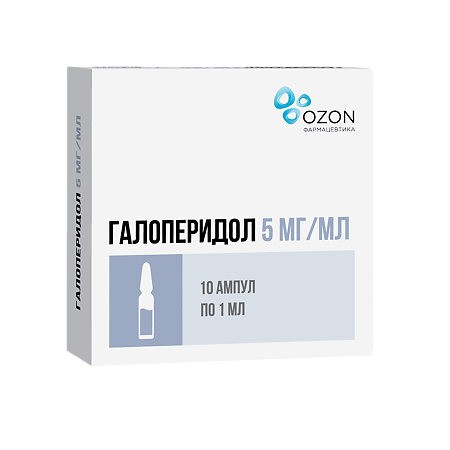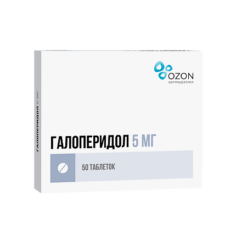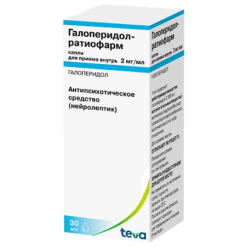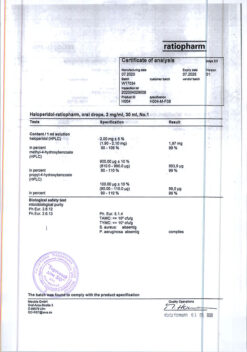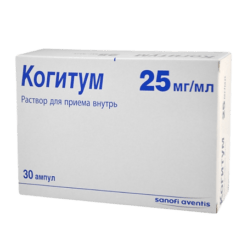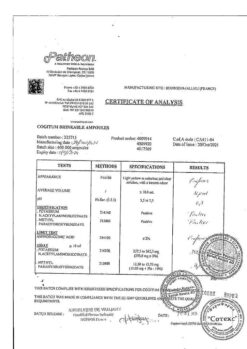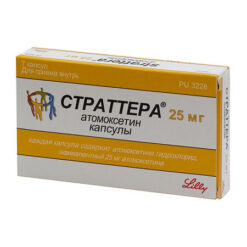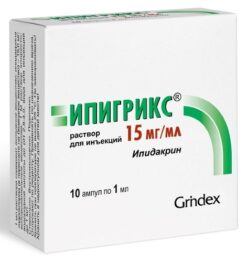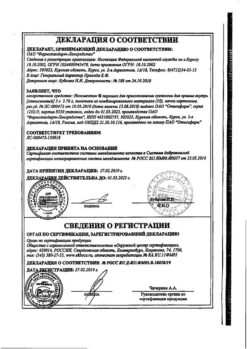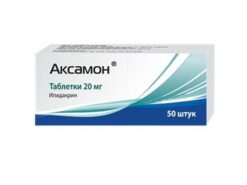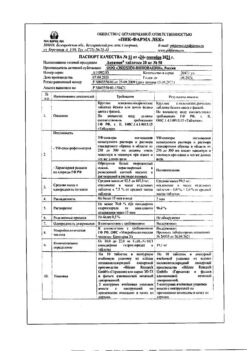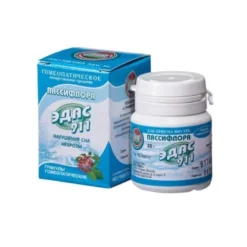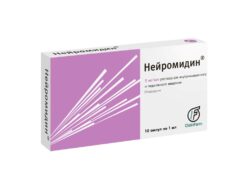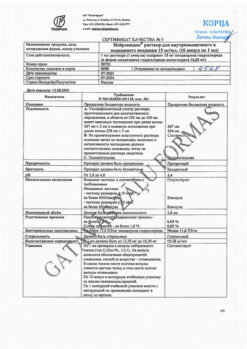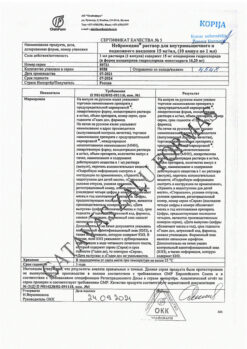No products in the cart.
Haloperidol, 5 mg/ml 1 ml 10 pcs
€3.00 €2.73
Out of stock
(E-mail when Stock is available)
Description
Pharmacotherapeutic group
Antipsychotic drug (neuroleptic)
ATX code: N05AD01
Pharmacodynamics:
Haloperidol is an antipsychotic (neuroleptic) butyrophenone derivative. It has a pronounced antipsychotic effect blocks postsynaptic dopamine receptors in mesolimbic and mesocortical structures of the brain. High antipsychotic activity is combined with a moderate sedative effect (in small doses it has an activating effect) and a pronounced antiemetic effect. It causes extrapyramidal disorders practically does not have m-cholinoblocking action.
Sedative action is caused by blockade of alpha-adrenoreceptors of reticular formation in brain stem; antiemetic action – by blockade of dopamine D2-receptors of trigger zone of vomiting center; hypothermic action and galactorrhea – by blockade of dopamine receptors of hypothalamus. Prolonged use is accompanied by changes in endocrine status in the anterior pituitary gland lobe; prolactin production increases and gonadotropic hormones production decreases.
Pharmacokinetics:
When administered intravenously the bioavailability is 100%. With intramuscular injection maximum concentration (Cmax) is reached in 20 minutes. Ratio
of concentration in erythrocytes to plasma concentration 1:12. Protein binding is approximately 92%. The concentration of haloperidol in tissues is higher than in blood The drug tends to cumulate in tissues. Easily penetrates through histohematic barriers including placental and blood-brain barriers and penetrates into breast milk.
Hapoperidol is metabolized in liver metabolite is not active. The CYPZase and/or CYP2D6 isoenzyme has been found to be involved in the metabolism of haloperidol. Haloperidol also undergoes oxidative N-dealkylation and glucuronidation. The plasma elimination half-life after intramuscular administration is 21 hours (17-25 hours). Haloperidol is excreted as metabolites in the feces – 60% (including 15% in the bile) and in the urine – 40% (including 1% unchanged).
Indications
Indications
Relief and treatment of acute psychotic disorders accompanied by psychomotor agitation.
Behavioral disorders such as aggression, hyperactivity, tendency to self-harm in the mentally retarded and in patients with organic brain lesions.
Treatment of nausea and vomiting.
Pharmacological effect
Pharmacological effect
Pharmacotherapeutic group
Antipsychotic (neuroleptic)
ATX code: N05AD01
Pharmacodynamics:
Haloperidol is an antipsychotic (neuroleptic) derivative of butyrophenone. It has a pronounced antipsychotic effect and blocks postsynaptic dopamine receptors in the mesolimbic and mesocortical structures of the brain. High antipsychotic activity is combined with a moderate sedative effect (in small doses it has an activating effect) and a pronounced antiemetic effect. Causes extrapyramidal disorders and has virtually no m-anticholinergic effect.
The sedative effect is due to the blockade of alpha-adrenergic receptors in the reticular formation of the brain stem; antiemetic effect – blockade of dopamine D2 receptors in the trigger zone of the vomiting center; hypothermic effect and galactorrhea – blockade of dopamine receptors of the hypothalamus. Long-term use is accompanied by a change in endocrine status in the anterior lobe of the pituitary gland, the production of prolactin increases and -gonadotropic hormones decrease.
Pharmacokinetics:
When administered intravenously, bioavailability is 100%. When administered intramuscularly, the maximum concentration (Cmax) is reached after 20 minutes. Attitude
concentration in erythrocytes to plasma concentration 1:12. Protein binding is approximately 92%. The concentration of haloperidol in tissues is higher than in the blood; the drug tends to accumulate in tissues. Easily penetrates histohematic barriers, incl. penetrates into breast milk through the placental and hematoencephalic.
Gapoperidol is metabolized in the liver; the metabolite is not active. It has been established that the CYP2D6 isoenzyme is involved in the metabolism of haloperidol. Haloperidol also undergoes oxidative N-dealkylation and glucuronidation. The half-life from plasma after intramuscular administration is 21 hours (17-25 hours). Haloperidol is excreted in the form of metabolites with feces – 60% (including bile -15%) and urine – 40% (including 1% unchanged).
Special instructions
Special instructions
Neuroleptic malignant syndrome: when using antipsychotic drugs, the occurrence of neuroleptic malignant syndrome (characterized by hyperthermia, generalized muscle rigidity, autonomic lability, impaired consciousness of the patient and increased levels of CPK in the blood plasma) has been reported. Additional features may include myoglobinuria (rhabdomyolysis) and acute renal failure. If these symptoms occur, antipsychotic treatment should be discontinued immediately and appropriate supportive care (eg, intravenous dantrolene infusions) should be initiated.
Extrapyramidal symptoms: with long-term use, symptoms characteristic of antipsychotics may occur – tremor, muscle rigidity, bradykinesia, akathisia, acute muscular dystonia or laryngeal dystonia. In these cases, antiparkinsonian drugs with anticolinergic action can be prescribed, but not as preventive therapy, since their use reduces the effectiveness of haloperidol.
Tardive dyskinesia: As with other antipsychotics, long-term use of haloperidol or its withdrawal may cause tardive dyskinesia. This syndrome is characterized by involuntary rhythmic twitching of the tongue, face, mouth or jaw. These signs are observed constantly in some patients. The syndrome may be masked when the course of therapy is resumed, the dose of haloperidol is increased, or another antipsychotic drug is prescribed. If signs of tardive dyskinesia appear, it is advisable to interrupt the course of therapy as soon as possible. Rhythmic, random jerking of the tongue may be an early sign of tardive dyskinesia. Canceling treatment at this early stage may prevent the development of this syndrome. In psychiatric practice,
Cases of sudden death have been reported in patients receiving antipsychotic drugs including haloperidol. Since during treatment with haloperidol it is possible to prolong the QT interval on the ECG, the benefit/risk ratio should be assessed when using the drug in patients with a disease of the circulatory system, with a family history of sudden death and/or a history of prolongation of the QT interval, especially with parenteral use of haloperidol. Before starting therapy, ECG monitoring is necessary (see section “Contraindications”).
The need for ECG monitoring should be determined individually in the treatment code. In patients with subarachnoid hemorrhage, fasting, alcohol abuse and uncorrected electrolyte disturbances, ECG and potassium levels should be closely monitored, especially in the initial phase of treatment until equilibrium plasma concentrations are achieved. Electrolyte imbalance may increase the risk of developing ventricular arrhythmias, so regular monitoring of electrolyte levels is recommended, especially in patients taking diuretics. During therapy, the dose should be reduced in case of prolonged QT interval and haloperidol should be discontinued immediately if the QT interval exceeds 500 ms. Haloperidol should be used with extreme caution in patients who are “slow metabolizers” of CYP2D6 and also when using cytochrome P450 inhibitors.
Concomitant use with other antipsychotics should be avoided.
Caution must be exercised when using haloperidol in patients with liver failure. With long-term use of the drug, periodic monitoring of the blood picture and liver function is necessary. Patients with epilepsy as well as patients with an increased tendency to convulsive conditions (chronic intoxication of both alcoholic and other origins, a history of traumatic brain injury, etc.) should be prescribed haloperidol with caution.
Caution should be exercised when using haloperidol in patients with renal failure and pheochromocytoma.
Thyroxine increases the toxicity of haloperidol, so patients with hyperthyroidism should use it only under the cover of adequate thyreostatic therapy.
Patients with schizophrenia respond to antipsychotic therapy with a delay. After finishing treatment with haloperidol, symptoms do not reappear until several weeks or months later. Sudden cessation of therapy with antipsychotic drugs, especially when used in high doses, can cause withdrawal symptoms (nausea, vomiting, insomnia) as well as relapse of the disease, so the drug must be discontinued gradually reducing the dose.
Patients who experience depression and psychosis due to psychopathological disorders should take haloperidol in combination with antidepressants.
If there is a need for simultaneous therapy with haloperidol and antiparkinsonian drugs after discontinuation of haloperidol, the use of the antiparkinsonian drug should be continued to prevent an increase in the severity of extrapyramidal symptoms, especially if the rate of elimination of the antiparkinsonian drug is higher. It should be taken into account that the combined use of haloperidol and anticholinergic drugs (including antiparkinsonian drugs) can lead to an increase in intraocular pressure.
Cases of venous thromboembolism have been reported with the use of antipsychotic drugs. Since patients receiving treatment with antipsychotic drugs often have acquired risk factors for the development of venous thromboembolism, which should be identified before starting treatment; When treating with haloperidol, it is necessary to take preventive measures.
Increased mortality has been observed in elderly people with dementia. Older people with dementia who received antipsychotics had a slightly increased risk of death compared with those who did not receive treatment. There is insufficient data to provide an accurate indicator of the magnitude of the risk and the reasons for its increase. Haloperidol is not indicated for the treatment of behavioral disorders associated with dementia in the elderly.
During drug therapy, you should avoid drinking alcohol. At the beginning of haloperidol therapy, and especially when used in high doses, sedation of varying degrees may occur and a decrease in attention, the severity of which increases with the use of alcoholic beverages.
Impact on the ability to drive vehicles. Wed and fur.:
During the treatment period, it is necessary to refrain from driving vehicles and engaging in other potentially hazardous activities that require increased concentration and speed of psychomotor reactions.
Active ingredient
Active ingredient
Haloperidol
Composition
Composition
Per 1 ml:
Active ingredient: haloperidol – 5.0 mg
Excipients: lactic acid – 5.0 mg, water for injection – up to 1.0 ml.
Pregnancy
Pregnancy
When administered in high doses during late pregnancy, butyrophenones can cause prolonged neurological impairment in newborns. In animal studies, the use of haloperidol during the period of organogenesis was accompanied by the development of side effects, including intrauterine fetal death, malformations such as cleft palate and defects in the development of the neural tube, as well as a decrease in brain mass and body weight, as well as behavioral disorders in the offspring.
The significance of these results when humans are exposed to therapeutic doses of haloperidol is unknown. Neonates exposed to antipsychotic drugs (including haloperidol) during the third trimester of pregnancy are at risk of developing extrapyramidal disorders and/or withdrawal symptoms after delivery. There are post-marketing reports of cases of agitation, hyper- and hypotonia, tremor, somnolence, respiratory distress, and feeding disorders in these newborns. These complications varied in severity and in some cases the symptoms resolved on their own and in others they required additional treatment or monitoring.
Haloperidol should be used during pregnancy only as a last resort if the expected benefit to the mother outweighs the potential risk to the fetus. The dose and duration of treatment should be as low and short as possible, respectively.
Haloperidol is excreted in breast milk: In cases where taking haloperidol is unavoidable, breastfeeding should be discontinued. In some cases, extrapyramidal symptoms have been observed in newborns whose mothers took haloperidol during lactation.
Contraindications
Contraindications
Hypersensitivity to haloperidol and other butyrophenone derivatives. Behavioral disorders associated with dementia in elderly patients, depression of the function of the central nervous system and comatose states of any etiology; diseases of the central nervous system accompanied by pyramidal and extrapyramidal disorders (Parkinson’s disease, etc.); clinically significant heart disease (including recent acute myocardial infarction; decompensated heart failure; arrhythmias treated with class IA and III antiarrhythmic drugs; prolongation of the QT interval; history of ventricular arrhythmia or ventricular arrhythmia of the pirouette type; clinically significant bradycardia; second or third degree heart block and uncorrected hypokalemia); prolactin-dependent tumors, simultaneous use with drugs that prolong the QT interval; children under 18 years of age.
With caution:
Epilepsy, angle-closure glaucoma, liver and/or kidney failure, hyperthyroidism (with symptoms of thyrotoxicosis), pulmonary-cardiac and respiratory failure (including in chronic obstructive pulmonary disease and acute infectious diseases), prostatic hyperplasia with urinary retention, alcoholism, pheochromocytoma.
Side Effects
Side Effects
The frequency of side effects is presented in the following gradation: very often (≥1/10) often (from ≥1/100 to <1/10) infrequently (from ≥1/1000 to <1/100) rarely (from ≥1/10000 to <1/1000) frequency unknown (cannot be estimated from the available data). From the blood and lymphatic system: uncommon - leukopenia; frequency unknown - agranulocytosis neutropenia pancytopenia thrombocytopenia.From the immune system: infrequently – hypersensitivity reactions; frequency unknown – anaphylactic reactions, toxic epidermal necrolysis Stevens-Johnson syndrome.From the endocrine system: rarely – hyperprolactinemia; frequency unknown – inadequate secretion of antidiuretic hormone.
Metabolic and nutritional disorders: frequency unknown – hypoglycemia.
Mental disorders: very often – agitation, insomnia; often depression psychotic disorders; infrequently – confusion, loss of libido, anxiety.
From the nervous system: very often – extrapyramidal disorders, hyperkinesia, headache; tardive dyskinesia oculogyric crisis dystonia dyskinesia akathisia bradykinesia hypokinesia hypertonicity drowsiness mask-like face tremor dizziness; infrequently – convulsions parkinsonism akinesia rigidity of the “cogwheel” type sedation involuntary muscle contracture; rarely – motor impairment, neuroleptic malignant syndrome, nystagmus.
From the organ of vision: often – visual impairment; infrequently – blurred visual perception.
From the cardiovascular system: often – decreased blood pressure, orthostatic hypotension; infrequently – tachycardia; ventricular fibrillation, pirouette-type arrhythmia, ventricular tachycardia, extrasystole; frequency unknown (when taking antipsychotic drugs) – venous thromboembolism including pulmonary embolism, deep vein thrombosis.
From the gastrointestinal tract: often – constipation, dry mouth, increased salivation; nausea vomiting.
From the respiratory system: infrequently – oedzhika; rarely – bronchospasm; frequency unknown – laryngeal edema, laryngospasm.
From the liver: often – deviation of liver enzymes; uncommon – hepatitis, jaundice; frequency unknown – acute liver failure cholestasis.
From the skin and subcutaneous tissue: often – skin rash; uncommon – photosensitivity reactions, urticaria, itching, hyperhidrosis; frequency unknown – leukocytoclastic vasculitis exfoliative vasculitis.
From the musculoskeletal system: infrequently – torticollis, muscle rigidity, muscle spasm, stiffness of skeletal muscles; rarely – trismus, muscle twitching.
From the kidneys and urinary tract: often – urinary retention.
From the reproductive system and mammary glands: often erectile dysfunction; uncommon – amenorrhea, dysmenorrhea, galactorrhea, pain and discomfort in the mammary/breast glands; menorrhagia menstrual disorders sexual dysfunction; frequency unknown – gynecomastia priapism.
General disorders and disorders at the injection site: infrequently – gait disturbance, hyperthermia, edema; frequency unknown – sudden death facial swelling hypothermia withdrawal syndrome in newborns.
Laboratory indicators: often – increase or decrease in body weight, prolongation of the QT interval on the ECG.
Interaction
Interaction
The simultaneous use of drugs that cause electrolyte imbalance requires increased caution – the risk of developing ventricular arrhythmias may increase. It is recommended to avoid the use of diuretics that cause hypokalemia and give preference to potassium-sparing diuretics.
Haloperidol potentiates the inhibitory effect on the central nervous system of antihypertensive drugs, narcotic analgesics, hypnotics, tricyclic antidepressants, drugs for general anesthesia, alcohol. Concomitant use of haloperidol with these drugs may cause respiratory depression. When used simultaneously with antiparkinsonian drugs (levodopa, etc.), the therapeutic effect of these drugs may be reduced due to the antagonistic effect on dopaminergic structures.
When used with methyldopa, disorientation, difficulty and slowing down of thinking processes may develop.
Haloperidol may reduce the intensity of the action of epinephrine and other sympathomimetics, causing a “paradoxical” decrease in blood pressure and tachycardia when used together.
Enhances the effect of peripheral m-anticholinergic drugs and most antihypertensive drugs (reduces the effect of guanethidine due to its displacement from alpha-adrenergic neurons and suppression of its uptake by these neurons). When combined with anticonvulsants (including barbiturates and other inducers of microsomal oxidation), the doses of the latter should be increased because haloperidol lowers the seizure threshold.
In addition, serum concentrations of haloperidol may also decrease. In particular, when drinking tea or coffee at the same time, the effect of haloperidol may be weakened.
Haloperidol may reduce the effectiveness of indirect anticoagulants; therefore, when taken together, the dose of the latter should be adjusted.
Haloperidol slows down the metabolism of tricyclic antidepressants and monoamine oxidase inhibitors (MAOIs), resulting in increased plasma concentrations and toxicity.
When used simultaneously with bupropion, it reduces the epileptic threshold and increases the risk of epileptic seizures.
When haloperidol is taken concomitantly with fluoxetine, quinidine, buspirone, the risk of side effects on the central nervous system, especially extrapyramidal reactions, increases. If concomitant use is necessary, the dose of haloperidol should be reduced. Inhibitors or substrates of CYP3A4 and CYP2D6 isoenzymes such as itraconazole buspirone venlafaxine alprazolam fluvoxamine quinidine fluoxetine sertraline chlorpromazine promethazine may increase plasma concentrations of haloperidol. A decrease in the activity of the CYP2D6 isoenzyme may lead to an increase in the concentration of haloperidol. Cases of QT prolongation and extrapyramidal symptoms have been reported with simultaneous use of haloperidol with ketoconazole (400 mg/day) and paroxetine (20 mg/day). Haloperidol dosage adjustment may be required.
The simultaneous use of haloperidol with drugs that prolong the QT interval, for example, antiarrhythmic drugs IA (including quinidine disopyramide procainamide) and III (including amiodarone sotalol dofetilide) of class, some antimicrobials (sparfloxacin moxifloxacin erythromycin intravenously) tricyclic antidepressants (including amitriptyline) some tetracyclic antidepressants (including maprotiline) other antipsychotics (including phenothiazines pimozide sertindole) some antihistamines (including terfenadine) cisapride bretylium tosylate some antimalarials (including quinine mefloquine) increases the risk of developing ventricular arrhythmia including arrhythmia of the “pirouette” type. Therefore, taking them together is not recommended (this list is not exhaustive).
Long-term combined use of haloperidol with drugs that are inducers of liver enzymes (carbamazepine, rifampicin, phenobarbital, etc.) leads to a decrease in the concentration of haloperidol in the blood plasma. If it is necessary to combine them, it may be necessary to increase the dose of haloperidol, but after discontinuation of the liver enzyme inducer, it is necessary to reduce the dose of haloperidol.
When used simultaneously with lithium salts, especially in high doses, it can cause irreversible neurointoxication and also increase extrapyramidal symptoms. If the above conditions occur in patients taking lithium and haloperidol simultaneously, therapy should be discontinued immediately.
When taken simultaneously with amphetamines, the antipsychotic effect of haloperidol and the psychostimulating effect of amphetamines are reduced due to the blockade of alpha-adrenergic receptors by haloperidol.
Haloperidol may decrease the effect of bromocriptine. Anticholinergic antihistamines (1st generation) antiparkinson drugs may increase anticholinergic side effects and reduce the antipsychotic effect of haloperidol.
Thyroxine may increase the toxicity of haloperidol. In case of hyperthyroidism, haloperidol can be prescribed only with simultaneous administration of appropriate thyreostatic therapy.
When used simultaneously with anticholinergic drugs, intraocular pressure may increase.
Overdose
Overdose
Symptoms: characterized by an increase in the severity of known pharmacological and side effects. The most important signs of overdose: severe extrapyramidal disorders, hypotension, severe lethargy. Extrapyramidal disorders manifest themselves in the form of muscle rigidity, general or local muscle tremor. Arterial hypertension may develop more often than hypotension. In some cases, a coma with respiratory depression and severe arterial hypotension may occur. It can be so severe that it can lead to shock. It is necessary to take into account the possibility of developing ventricular arrhythmia with prolongation of the QT interval.
Treatment: there is no specific antidote; symptomatic therapy should be carried out. In a comatose state, it is necessary to support the function of the respiratory system by introducing an orotracheal or endotracheal tube. If respiratory depression occurs, it may be necessary to perform mechanical ventilation. Monitoring of the ECG and vital hemodynamic parameters is necessary until the ECG normalizes. In case of severe arterial hypotension or circulatory failure, intravenous administration of a sufficient volume of blood plasma fluid or concentrated albumin is carried out, as well as the introduction of vasopressors (dopamine or norepinephrine). Epinephrine should not be used as it can cause severe hypotension in combination with haloperidol. For severe extrapyramidal disorders, antiparkinsonian drugs are used parenterally (benztropine mesylate for adults in a dose of 1-2 mg intravenously or intramuscularly). Discontinuation of these drugs should be done with caution, since abrupt cessation of their administration may lead to relapse of extrapyramidal disorders.
Storage conditions
Storage conditions
In a place protected from light at a temperature not exceeding 25 ° C. Do not freeze.
Keep out of the reach of children.
Shelf life
Shelf life
2 years. Do not use after expiration date.
Manufacturer
Manufacturer
Ozon, Russia
Additional information
| Shelf life | 2 years. Do not use after the expiration date. |
|---|---|
| Conditions of storage | In the dark place at the temperature not more than 25 °С. Do not freeze. Keep out of reach of children. |
| Manufacturer | Ozon, Russia |
| Medication form | solution |
| Brand | Ozon |
Other forms…
Related products
Buy Haloperidol, 5 mg/ml 1 ml 10 pcs with delivery to USA, UK, Europe and over 120 other countries.

